Thirty-six Views of Mount Fuji

Thirty-six Views of Mount Fuji (富嶽三十六景 Fugaku Sanjūrokkei) is a series of landscape prints by the Japanese ukiyo-e artist Hokusai (1760–1849). The series depicts Mount Fuji from different locations and in various seasons and weather conditions. Despite its name, it actually consists of 46 prints, with 10 of them being added after the initial publication.
The series was produced from c. 1830 to 1832, when Hokusai was in his seventies and at the height of his career, and published by Nishimura Yohachi.[1][2] Among the prints are three of Hokusai's most famous: Under the Wave off Kanagawa (or The Great Wave); South Wind, Clear Sky; and Rainstorm Beneath the Summit.[3] The series has been described as the artist's "indisputable colour-print masterpiece".[4]
History
Mount Fuji is a popular subject for Japanese art due to its cultural and religious significance. This belief can be traced to The Tale of the Bamboo Cutter, where a goddess deposits the elixir of life on the peak. As the historian Henry Smith[5] explains, "Thus from an early time, Mt. Fuji was seen as the source of the secret of immortality, a tradition that was at the heart of Hokusai's own obsession with the mountain."[6]
The most famous single image from the series is widely known in English as The Great Wave off Kanagawa (神奈川沖浪裏 Kanagawa-oki nami-ura), although a more literal translation might be, "Off Kanagawa, the back (or underside) of a wave." It depicts three boats being threatened by a large wave while Mount Fuji rises in the background. While generally assumed to be a tsunami, the wave was probably intended to simply be a large ocean wave.
Each of the images was made through a process whereby an image drawn on paper was used to guide the carving of a wood block. This block was then covered with ink and applied to paper to create the image (see Woodblock printing in Japan for further details). The complexity of Hokusai's images includes the wide range of colors he used, which required the use of a separate block for each color appearing in the image.
While Hokusai's Thirty-six Views of Mount Fuji is the most famous ukiyo-e series to focus on Mount Fuji, there are several other works with the same subject, including Hiroshige's series Thirty-six Views of Mount Fuji and Hokusai's subsequent book One Hundred Views of Mount Fuji.[6] From c. 1889 to 1892, the series of Thirty-six Bizarre Selections of Transformation, the parody of number 36, was produced by Yoshitoshi, and published by Sasaki Toyokichi.
The French artist Henri Rivière (1864-1951) published the set of color lithographs "Thirty-six views of the Tour Eiffel" in 1902, inspired by the seminal print set of Hokusai, one of the many influences of Japanese art on late 19th century and early 20th century French art (Japonism, known as "Japonisme" in French)
Prints
Original thirty-six
These images are of modern facsimile prints made using the same techniques.
| № | Image | English title | Japanese title |
|---|---|---|---|
| 1 |  |
The Great Wave off Kanagawa | 神奈川沖浪裏
Kanagawa oki nami-ura |
| 2 | 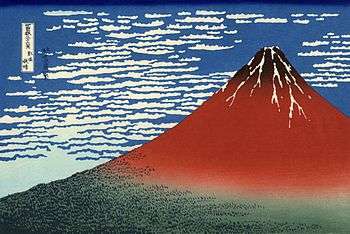 |
South Wind, Clear Sky (There is another impression of 凱風快晴, also known as Red Fuji) | 凱風快晴
Gaifū kaisei |
| 3 |  |
Rainstorm Beneath the Summit | 山下白雨
Sanka hakuu |
| 4 | 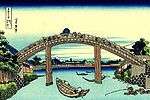 |
Under Mannen Bridge at Fukagawa | 深川万年橋下
Fukagawa Mannen-bashi shita |
| 5 | 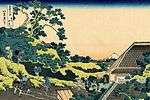 |
Sundai, Edo | 東都駿台
Tōto sundai |
| 6 |  |
Cushion Pine at Aoyama | 青山円座松
Aoyama enza-no-matsu |
| 7 | 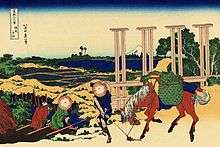 |
Senju, Musashi Province | 武州千住
Bushū Senju |
| 8 | 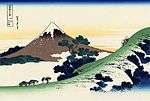 |
Inume Pass, Kōshū | 甲州犬目峠
Kōshū inume-tōge |
| 9 | 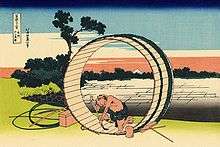 |
Fuji View Field in Owari Province | 尾州不二見原
Bishū Fujimigahara |
| 10 |  |
Ejiri in Suruga Province | 駿州江尻
Sunshū Ejiri |
| 11 |  |
A sketch of the Mitsui shop in Suruga in Edo (present-day Muromachi, Tokyo) | 江都駿河町三井見世略図
Kōto Suruga-cho Mitsui Miseryakuzu |
| 12 | 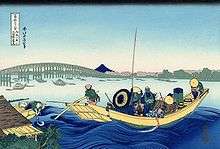 |
Sunset across the Ryōgoku bridge from the bank of the Sumida River at Onmayagashi | 御厩川岸より両国橋夕陽見
Ommayagashi yori ryōgoku-bashi yūhi mi |
| 13 | 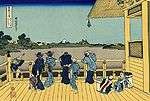 |
Sazai hall - Temple of Five Hundred Rakan | 五百らかん寺さざゐどう
Gohyaku-rakanji Sazaidō |
| 14 |  |
Tea house at Koishikawa. The morning after a snowfall | 礫川雪の旦
Koishikawa yuki no ashita |
| 15 |  |
Shimomeguro | 下目黒
Shimomeguro |
| 16 | 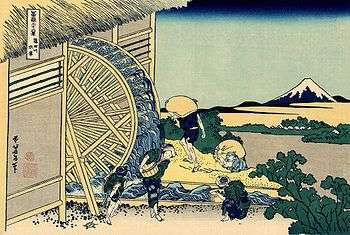 |
Watermill at Onden | 隠田の水車
Onden no suisha |
| 17 | 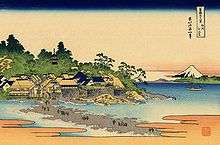 |
Enoshima in Sagami Province | 相州江の島
Soshū Enoshima |
| 18 |  |
Shore of Tago Bay, Ejiri at Tōkaidō | 東海道江尻田子の浦略図
Tōkaidō Ejiri tago-no-uraryakuzu |
| 19 |  |
Yoshida at Tōkaidō | 東海道吉田
Tōkaidō Yoshida |
| 20 |  |
The Kazusa Province sea route | 上総の海路
Kazusa no kairo |
| 21 | 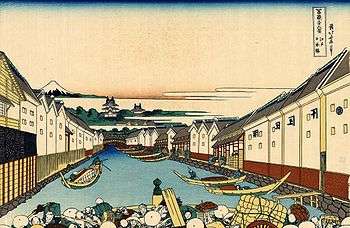 |
Nihonbashi bridge in Edo | 江戸日本橋
Edo Nihon-bashi |
| 22 | 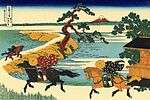 |
Barrier Town on the Sumida River | 隅田川関屋の里
Sumidagawa Sekiya no sato |
| 23 |  |
Bay of Noboto | 登戸浦
Noboto-ura |
| 24 |  |
The lake of Hakone in Sagami Province | 相州箱根湖水
Sōshū Hakone kosui |
| 25 | 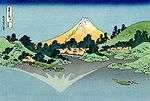 |
Mount Fuji reflects in Lake Kawaguchi, seen from the Misaka Pass in Kai Province | 甲州三坂水面
Kōshū Misaka suimen |
| 26 |  |
Hodogaya on the Tōkaidō | 東海道程ケ谷
Tōkaidō Hodogaya |
| 27 | 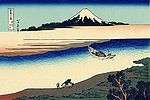 |
Tama River in Musashi Province | 武州玉川
Bushū Tamagawa |
| 28 | 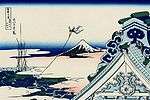 |
Asakusa Hongan-ji temple in the Eastern capital [Edo] | 東都浅草本願寺
Tōto Asakusa honganji |
| 29 | 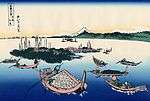 |
Tsukuda Island in Musashi Province | 武陽佃島
Buyō Tsukuda-jima |
| 30 |  |
Shichiri beach in Sagami Province | 相州七里浜
Soshū Shichiri-ga-hama |
| 31 | 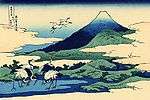 |
Umezawa in Sagami Province | 相州梅沢庄
Soshū umezawanoshō |
| 32 |  |
Kajikazawa in Kai Province | 甲州石班沢
Kōshū Kajikazawa |
| 33 |  |
Mishima Pass in Kai Province | 甲州三嶌越
Kōshū Mishima-goe |
| 34 |  |
Mount Fuji from the mountains of Tōtōmi | 遠江山中
Tōtōumi sanchū |
| 35 |  |
A View of Mount Fuji Across Lake Suwa (Lake Suwa in Shinano Province) | 信州諏訪湖
Shinshū Suwa-ko |
| 36 |  |
Ushibori in Hitachi Province | 常州牛掘
Jōshū Ushibori |
Additional 10
| № | Image | English title | Japanese title |
|---|---|---|---|
| 1 | 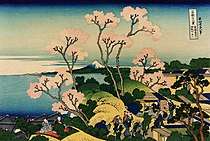 |
Goten-yama-hill, Shinagawa on the Tōkaidō | 東海道品川御殿山の不二
Tōkaidō Shinagawa Goten'yama no Fuji |
| 2 |  |
Honjo Tatekawa, the timberyard at Honjo, Sumida | 本所立川
Honjo Tatekawa |
| 3 | 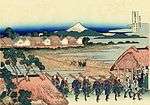 |
Pleasure District at Senju | 従千住花街眺望の不二
Senju Hana-machi Yori Chōbō no Fuji |
| 4 | 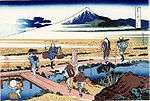 |
Nakahara in Sagami Province | 相州仲原
Sōshū Nakahara |
| 5 | 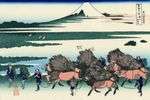 |
Ōno Shinden in Suruga Province | 駿州大野新田
Sunshū Ōno-shinden |
| 6 | 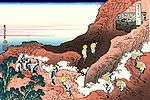 |
Climbing on Fuji | 諸人登山
Shojin tozan |
| 7 |  |
The Tea plantation of Katakura in Suruga Province | 駿州片倉茶園の不二
Sunshū Katakura chaen no Fuji |
| 8 | 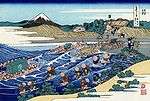 |
The Fuji from Kanaya on the Tōkaidō | 東海道金谷の不二
Tōkaidō Kanaya no Fuji |
| 9 | 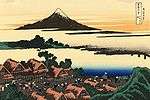 |
Dawn at Isawa in Kai Province | 甲州伊沢暁
Kōshū Isawa no Akatsuki |
| 10 | 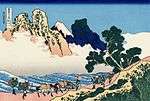 |
The back of Fuji from the Minobu river | 身延川裏不二
Minobu-gawa ura Fuji |
Exhibitions
A collection of Thirty-six Views of Mount Fuji prints contained in the wellness spa of the Costa Concordia was lost during the collision of the ship on January 13, 2012.[7]
All forty-six prints (the original thirty-six plus the ten additions) were featured in the exhibition "Hokusai: 36 Views of Mount Fuji" at the Freer Gallery of Art and the Arthur M. Sackler Gallery, the Smithsonian's museums of Asian art, in the spring of 2012.
The Thirty-six Views of Mount Fuji prints were displayed at the Museum of Fine Arts, Boston as part of a Hokusai exhibit April 5 through August 9, 2015.[8]
The Thirty-six Views of Mount Fuji prints were displayed at the National Gallery of Victoria, Melbourne, Australia as part of a Hokusai exhibit 21 July through 22 October 2017, featuring two copies of The Great Wave off Kanagawa, one from the NGV and one from Japan Ukiyo-e Museum.[9]
See also
Notes
- ↑ Calza, p. 30
- ↑ Calza, p. 470
- ↑ Calza, p. 30
- ↑ Calza, p. 470
- ↑ Smith, Henry (1988). One Hundred Views of Mount Fuji. Thames and Hudson. ISBN 9780500235188.
- 1 2 Smith
- ↑ "Costa Concordia: Threat of treasure hunters". To Be A Travel Agent.
- ↑ "Hokusai Features Legendary Artist, Best Known for Iconic Great Wave".
- ↑ "Hokusai".
References
External links
| Wikimedia Commons has media related to 36 Views of Mount Fuji. |
- Hokusai: 36 Views of Mount Fuji exhibition at the Freer and Sackler Galleries
- Hokusai's 36 Views of Mount Fuji
- A short biography of Hokusai including a section on the 36 Views of Mt. Fuji series.
- Jim Breen's ukiyo-e page on Hokusai and the 36 Views
- 葛飾北斎の富士山・富嶽三十六景 (in Japanese)
- Educational Audio Tour of The Great Wave